Temples possessed tremendous social and political power. They employed a variety of people, from priests to craftsmen. Temples also owned farmland, which provided them with food and goods. They received booty from every military campaign, including prisoners. Pharaohs often gifted a temple with more land or with other goods.
The classification of temples in Egypt usually refers to two main types:
- Cultus (religious): temples dedicated to a main deity, most having other gods as well. These temples provided a 'residence' or shelter for the gods. Here, priests used to perform rituals and ceremonies, give offerings, pray and tend to the needs of the gods. Some festivals also took place in cultus temples, which allowed all other Egyptians to participate to rituals of worship.
- Mortuary: for a pharaoh’s funerary cult. The funerary cult offered food and clothing to the departed pharaoh to ensure s/he would continue helping the people of Egypt. Mortuary temples were only built for the pharaoh. At first, these temples were part of the tomb complex. Most pyramids had a mortuary temple beside them for the pharaoh buried in the temple. Later pharaohs wanted to hide their tombs so they built their temples away from their tombs.
Famous Temples: The Theban Necropolis
The Theban Necropolis temples were on the west bank of the Nile near the Valley of the Kings. Some of the most famous temples built there were Deir-El-Bahri, Medinet Habu, and the Ramesseum. Deir-El-Bahri has several buildings including the mortuary temples of Thutmose IIIand Hatshepsut. The temple of Thutmose III suffered extensive damage due to a landslide in antiquity. Later people took stones from the temple to build later structures.
Hatshepsut's Mortuary Temple
Hatshepsut’s mortuary temple is well preserved and Egyptologists reconstructed it during the 20th century. Some scholars believe the scientists made errors during its reconstruction. It is the centerpiece of Deir-El-Bahri and the builders carved it into the cliff face. The temple consists of several terraces with ramps leading up to the top of the different terraces. The building is 97 feet tall and most of its statues were destroyed by rulers who wanted to erase Hatshepsut’s rule.
Click here to discover more about The Temple of Hatshepsut
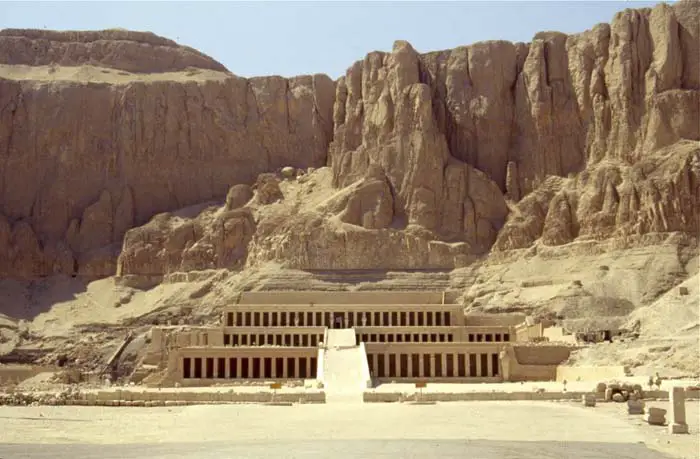
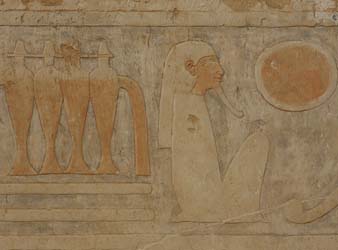 - Reliefs at the Temple of Hatshepsut
- Reliefs at the Temple of Hatshepsut
Reliefs on the Birth Colonnade
The keeper of the Theban Necropolis, Anubis (the god of mummification and afterlife), has a special chapel dedicated to him on the northern end of the colonnade.
Reliefs on the Birth Colonnade
The Third Level
Statues of Horus, in falcon form, flank the ramp that leads from the second courtyard to the third level. This third level houses a portico with dual rows of columns that face the front. Behind this is a courtyard and several chambers running off of it. Enormous statues of Hatshepsut made up the outlying columns, with octagonal shaped columns along the inside.
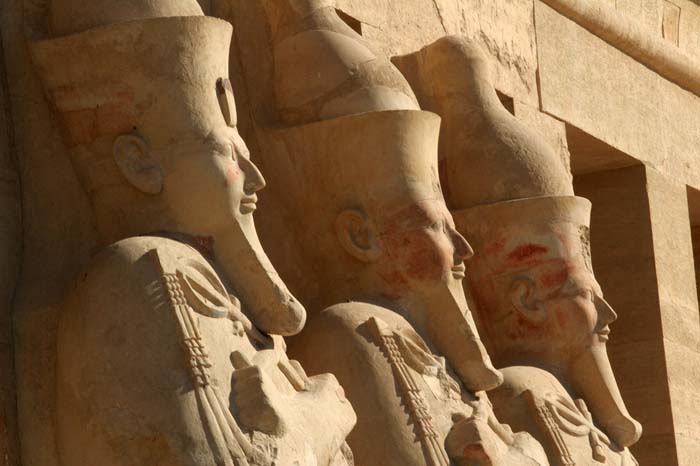
© Ray Euden - Osiris statues of Hatshepsut

© Ray Euden - Osiris statues of Hatshepsut
Quick Facts About The Temple of Hatshepsut
- Reliefs abound in this temple. Some are of Hatshepsut’s birth and her visit to Punt. Others exist of marine fauna with clear zigzag lines representing water. Still others exist of people reaching their tree houses by ladders.
- Both the leader of Punt’s wife and Hatshepsut are obese in the reliefs. Corpulence in the days of ancient Egypt was quite rare.
- Thutmose III ordered Hatshepsut’s name and image chiseled from the walls after her death. He built his own temple directly to the west of hers, across the Nile.
- Even though Thutmose III was responsible for much of the damage and desecration of Hatshepsut’s likeness, even more damage was caused by Akhenaten, an 18th dynasty heretic who only allowed images of the Aten, the sun god.
- From the third level (which is off limits to the public) a doorway leads to two chapels, one dedicated to the Royal cult, and the other dedicated to the solar cult. Here, all images of Hatshepsut that were destroyed were replaced with images of Thutmose III.
- Pointing directly toward Hatshepsut’s tomb, the Sanctuary of Amun lies behind the third level courtyard.
The Ramesseum
The Ramesseum is the temple built by Ramesses II and it took over twenty years to complete. At least, two pylons are part of this temple and it also has a Hypostyle hall. The builders placed several monumental statues of the pharaoh in this temple. The inscriptions record some of the pharaoh’s military actions. A temple dedicated to his first wife and his mother is next to the temple. The flooding of the Nile has damaged this temple and it is not as well preserved as other examples.
Ramesseum Hypostyle Hall Columns.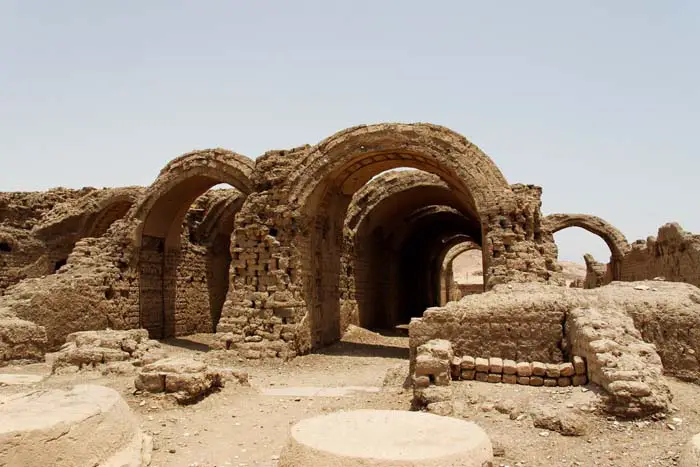
above is Granaries at the Ramesseum
The Ramesseum Quick Facts
- Funerary or mortuary temple of Ramesses II who reigned between 1279-1213 BC.
- Constructed on the western bank of the Nile River in ancient Thebes in Upper Egypt.
- Famous for the 57 foot high statue of Ramesses II which now sits in ruins with only fragments left behind. This enormous statue was transported 170 miles over land to the Ramesseum.
- Scenes and reliefs inside the temple include the Battle of Kadesh, Siege of Dapur and Tunip, Ramesses II being crowned by Sekhmet, Amon-Ra and Khonsu, Barques procession, and litanies to Ptah and Ra-Harakty.
- A temple dedicated to Ramesses II’s mother, Tuya, and his beloved chief wife, Nefertari stands to the north of the Hypostyle hall.
Medinet Habu
Medinet Habu is the temple of Ramesses III. Reliefs in this temple depict the arrival and defeat of the Sea Peoples. It is 690 X 1000ft and there are over 75,000 sq. ft. of wall reliefs. A mud brick wall surrounds this temple and has aided its preservation.
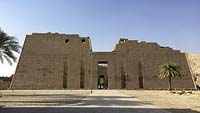
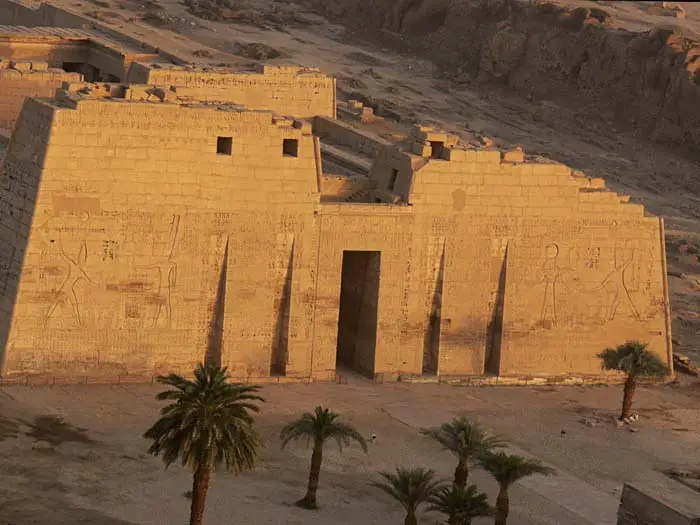
View of Medinet Habu
A Magical Site
Through the centuries, ancient Egyptians, as well as modern day local farmers considered the Medinet Habu temple to have magical powers. The temple protected the Theban people during the late 20th century dynasty during the Libyan invasions and was the site of many annual festivals in association with Amun, in his form as God of Fertility and Creator.
Location:
West Bank, opposite Luxor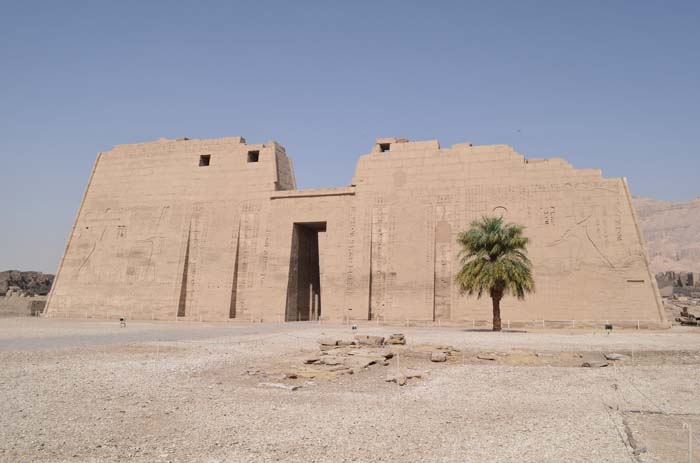
In the southeast corner is the Sacred Lake, where women came to bathe and pray for fertility. A Nilometer is located here as well. Interestingly, a Nilometer measured both the Nile’s clarity and water level.
The first pylon shows various reliefs of war campaigns including some that are exaggerated for an impressive effect on the visitor. The first pylon’s inner wall shows scribes counting severed hands and genitals of enemies.
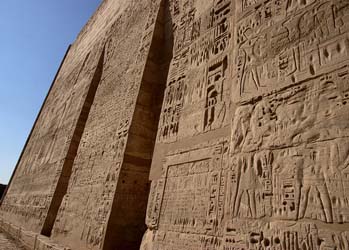
Reliefs on the First Pylon
Beyond the first pylon is a large first court. Surrounded by columns, the columns on the right depict Osiride statues of Ramses III being attended to by little queens. To the left of the first court is the royal Palace, and in the center of the adjoining wall is the Window of Appearances. The Window of Appearances is where the King rewarded devoted commanders with golden collars.
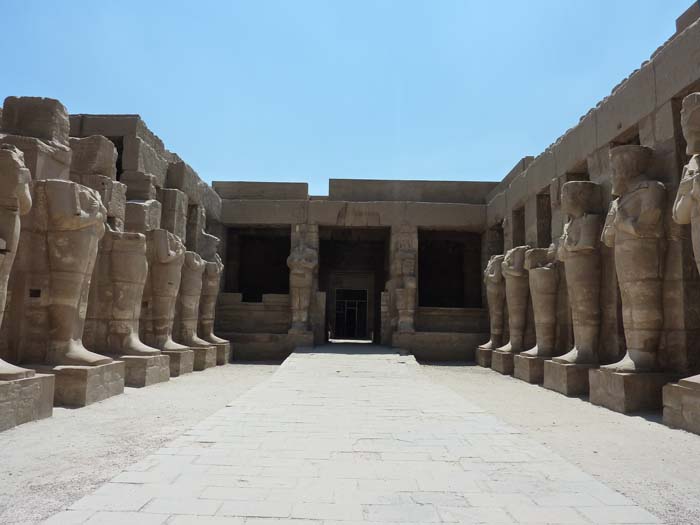
© Hannah Pethen - First court of the Medinet Habu temple
The second pylon is special because not only does it show reliefs of Ramses III leading prisoners of war to Amun and Mut, it also boasts inscriptions declaring his Asia Minor victories. Winged cobras and sun discs decorate the ceiling in the gateway.
The Hypostyle Hall past the second court now has no roof, but originally had a raised center aisle. Hieroglyph-covered bases of 24 pillars are all that remains. Five chapels dedicated to Ptah, Sokar, Osiris, Ramses II and Ramses III are to the right of the Hypostyle Hall, and chambers to the left are believed to have once held treasure.
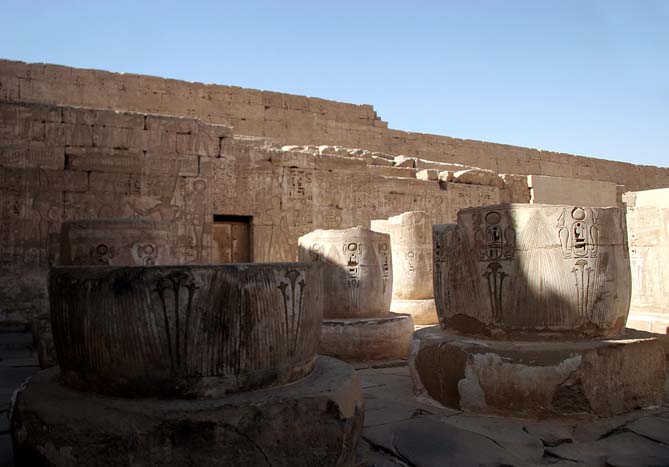
© Elena Pleskevich - Pillar Bases in the Hypostyle Hall
To the left, the hall contains the funerary chamber of Ramesses III. Here, Thoth is inscribing the king’s name on the sacred tree of Heliopolis. Opposite this chamber is a roofless chamber that at one time contained an altar dedicated to Ra.
Statues of Ramses III accompanied by Thoth and Maat flank the second hall’s central aisle. This aisle leads back into sanctuaries dedicated to the Theban Triad. There is even a false door that was to be used for Ramses III’s soul.
Sea Peoples
During the king’s reign, many foreigners invaded ancient Egypt including the “Sea Peoples” and the Libyans. These “Sea Peoples,” based on evidence derived from the temple walls, were made up of the Peleset and Tjeker, also known as the Minoans of Crete. These inscriptions and reliefs were added to the mortuary temple walls eight years into the king’s reign.
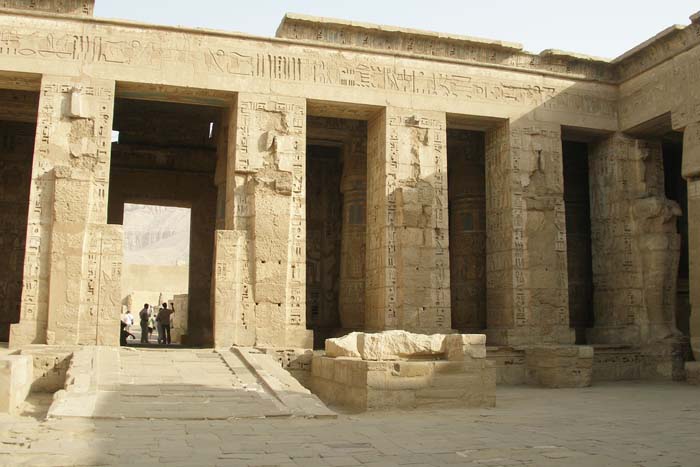
© Vyacheslav Argenberg - Reliefs on the Walls of the Temple
Quick Medinet Habu Facts
- The northern outer walls contain the best, most well-preserved reliefs. Ramses III’s battle relief runs the whole length of this wall.
- Some of the reliefs found in the Medinet Habu Temple include a religious calendar, Ramses III expedition into Upper Egypt, Hunting the wild bull, Destruction of Hittite strongholds, Feast of Sokar, Ramses III making offerings to Amun, Naval battle against the Sea Peoples, and Equestrian scenes.
- Economic difficulties and internal strife caused the collapse of the 20th Dynasty. Considered the last great Pharaoh, Ramses III saw the decline of Egyptian power during his long reign.
- The excavation of Medinet Habu started in 1859 by the Egyptian Antiquities Service. Partially-intact enclosure walls surround the site, so a ride in a hot air balloon provides the best view of the complex.
The Temples of Ancient Egypt
Religion was a vital part of Egyptian Society and temples formed an important part of daily life. The people did not gather to worship in the temple. They brought offerings to the gods and participated in various festivals. Many private homes also had a small shrine where the home owners could make offerings to specific gods.
Temples possessed tremendous social and political power. They employed a variety of people, from priests to craftsmen. Temples also owned farmland, which provided them with food and goods. They received booty from every military campaign, including prisoners. Pharaohs often gifted a temple with more land or with other goods.
The classification of temples in Egypt usually refers to two main types:
- Cultus (religious): temples dedicated to a main deity, most having other gods as well. These temples provided a 'residence' or shelter for the gods. Here, priests used to perform rituals and ceremonies, give offerings, pray and tend to the needs of the gods. Some festivals also took place in cultus temples, which allowed all other Egyptians to participate to rituals of worship.
- Mortuary: for a pharaoh’s funerary cult. The funerary cult offered food and clothing to the departed pharaoh to ensure s/he would continue helping the people of Egypt. Mortuary temples were only built for the pharaoh. At first, these temples were part of the tomb complex. Most pyramids had a mortuary temple beside them for the pharaoh buried in the temple. Later pharaohs wanted to hide their tombs so they built their temples away from their tombs.
Famous Temples: The Theban Necropolis
The Theban Necropolis temples were on the west bank of the Nile near the Valley of the Kings. Some of the most famous temples built there were Deir-El-Bahri, Medinet Habu, and the Ramesseum. Deir-El-Bahri has several buildings including the mortuary temples of Thutmose IIIand Hatshepsut. The temple of Thutmose III suffered extensive damage due to a landslide in antiquity. Later people took stones from the temple to build later structures.
Hatshepsut's Mortuary Temple
Hatshepsut’s mortuary temple is well preserved and Egyptologists reconstructed it during the 20th century. Some scholars believe the scientists made errors during its reconstruction. It is the centerpiece of Deir-El-Bahri and the builders carved it into the cliff face. The temple consists of several terraces with ramps leading up to the top of the different terraces. The building is 97 feet tall and most of its statues were destroyed by rulers who wanted to erase Hatshepsut’s rule.
Click here to discover more about The Temple of Hatshepsut
The Ramesseum
The Ramesseum is the temple built by Ramesses II and it took over twenty years to complete. At least, two pylons are part of this temple and it also has a Hypostyle hall. The builders placed several monumental statues of the pharaoh in this temple. The inscriptions record some of the pharaoh’s military actions. A temple dedicated to his first wife and his mother is next to the temple. The flooding of the Nile has damaged this temple and it is not as well preserved as other examples.
Click here to discover more about The Ramesseum
Medinet Habu
Medinet Habu is the temple of Ramesses III. Reliefs in this temple depict the arrival and defeat of the Sea Peoples. It is 690 X 1000ft and there are over 75,000 sq. ft. of wall reliefs. A mud brick wall surrounds this temple and has aided its preservation.
Click here to discover more about Medinet Habu
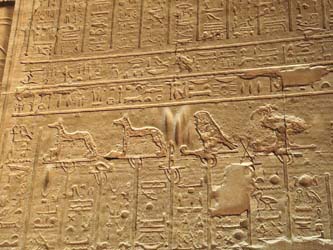
© isawnyu - Wall reliefs at Kom Ombo temple
Other Famous Temples and Temple Complexes
Luxor Temple
This temple is on the east bank of the Triad. The Theban Triad (Amun, Mut and Khonsu) was worshiped here. During the Opet Festival, the statue of Amun at Karnak traveled to the Luxor Temple. This was a festival to promote fertility
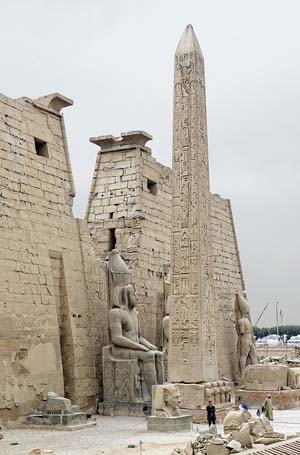
Entrance Pylon at Luxor
Luxor was an important site to the ancient Egyptians. This is shown by the fact that Alexander the Great rebuilt part of the temple and added his own propaganda. He rebuilt the barque shrine inside the original core of the temple. Alexander had images carved on the shrine showing him as a pharaoh, sacrificing to Amun.
The Romans also used Luxor. They incorporated it into a fortress and rededicated Luxor to the cult of the Emperor. After Christianity became the religion of the Empire, the Romans built several churches in or near Luxor. They built one of these churches inside the Great Court.
In the 13th Century, Muslims built a mosque over the church in the Great Court. This mosque is still in use today. Scholars have determined that Luxor has been an active religious center for at least 3,000 years.
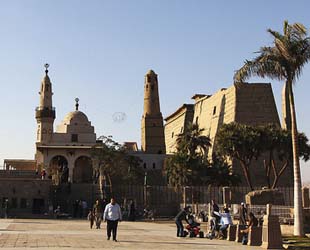
© Ahmad Rafiuddin - Mosque at Luxo
Excavation
The first modern European to identify Thebes and document his exploration of Luxor was Claude Sicard. He was a Jesuit and he visited Thebes in 1715. His work helped excite Europe’s interest in Egypt. This lead to the scientific expedition attached to Napoleon’s army.
This expedition measured and recorded the temple of Luxor in the early 1800s. They also found the Rosetta stone, which led to the decipherment of hieroglyphics. Scholars were then able to read the inscriptions at Luxor.
Egyptologists have continued to restore and maintain the Luxor temple. They have also conducted excavations and one of these found a cache of artifacts. When the Romans rededicated Luxor, they buried older statues of deities and pharaohs in a cache. In 1989, Egyptologists found this cache and some of the statues they found are in the Luxor Museum.
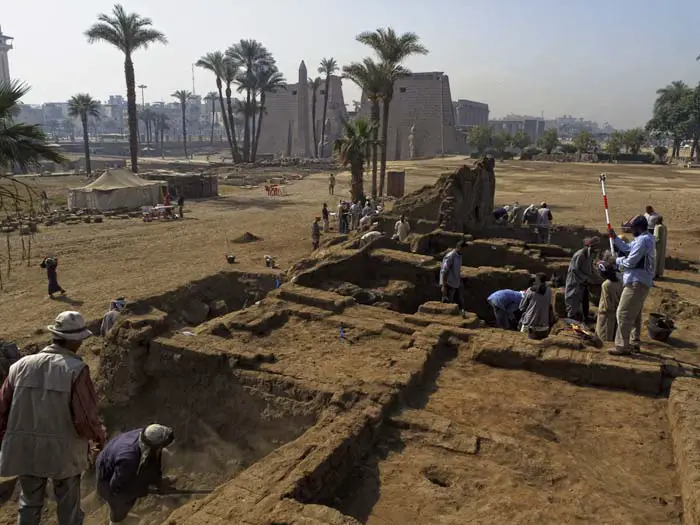
© Scott D. Haddow - Excavations performed at Luxor
Festivals
The most important Festival at Luxor was the Beautiful Feast of Opet. It was from this festival that the version of Amun worshiped at Luxor got his name, Amenemope. This name meant “Amun of the Opet” and the Egyptians called the temple the Southern Opet. The festival took place yearly during Akhet.
Akhet was the season when the Nile flooded. The Egyptians associated the Opet Festival with fertility. It lasted for anywhere from eleven days to one month, depending on the period of Egypt’s history. During the festival, the statues of Amun, Mut and Khonsu at Karnak traveled to Luxor in small boats.
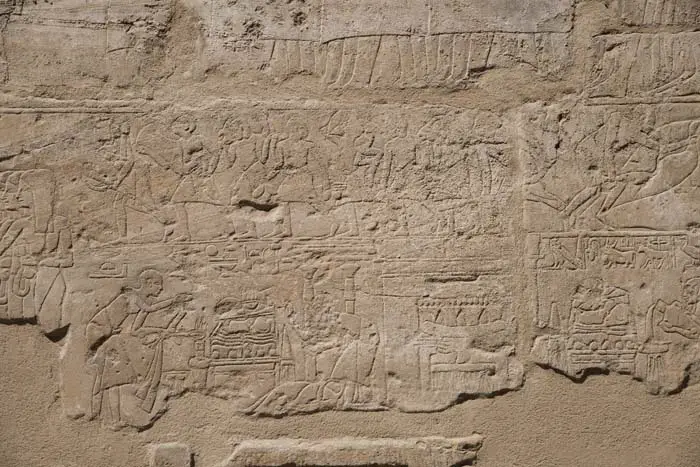
© kairoinfo4u - Relief at Luxor, depicting the Beautiful Feast of Opet
The exact meaning of some of the festival’s parts which are depicted at Luxor are difficult to determine. Scholars believe there was a sacred marriage ceremony involving the king and queen that was a part of the festival. They also think the Egyptians believed the festival restored the Pharaoh’s power. There was a ritual coronation ceremony where the king received crowns from different deities.
Luxor Temple Facts
- Luxor has been an active religious site for at least 3,000 years.
- Scholars believe the Egyptians thought the Opet Festival at Luxor restored the Pharaoh’s power.
- Many pharaohs added to or restored Luxor.
- A cache of statues found at Luxor contained some of the most beautiful examples of Egyptian statuary found to date.
- The Egyptians dedicated Luxor to Amun and the cult practices were connected to his temple at Karnak.
- The Egyptians oriented Luxor north to south to face Karnak; instead of orienting it east to west like most Egyptian temples.
- Luxor was located in the center of Thebes.
Karnak
Karnak is the site of the largest temple complex in Egypt and the second largest ancient complex after Angkor Wat in Cambodia. It was the center of the worship of Amun and had four separate temple complexes (one of which was dismantled). The three extant precincts contain temples for Amun, Mut and Montu. Priests built chapels for other deities in each precinct and each contained its own sacred pool. Karnak’s construction is diverse because at least thirty different pharaohs built the precincts.
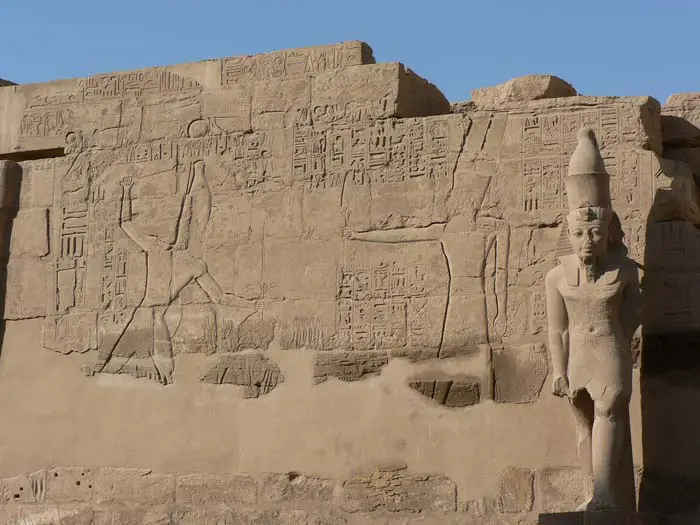
© eviljohnius - Wall Reliefs at Karnak
Deities at Karnak Temple
Egyptians worshiped many deities at Karnak but each precinct had a main temple. The three deities worshiped in these were Amun, Mut and Montu. Some of the other deities who had temples or chapels were Osiris, Ptah and Khonsu. The Theban Triad (Amun, Mut and Khonsu) traveled from Karnak to visit the mortuary temples on the West bank or to visit Luxor.
Karnak Temple Layout
The three temple complexes are in a North-South alignment. Amun’s precinct is the largest and in the center. Mut’s precinct is the South-most and the second largest. Montu’s precinct is the smallest and the highest North. The processional way that links Karnak and Luxor goes past the Western wall of Mut’s precinct.
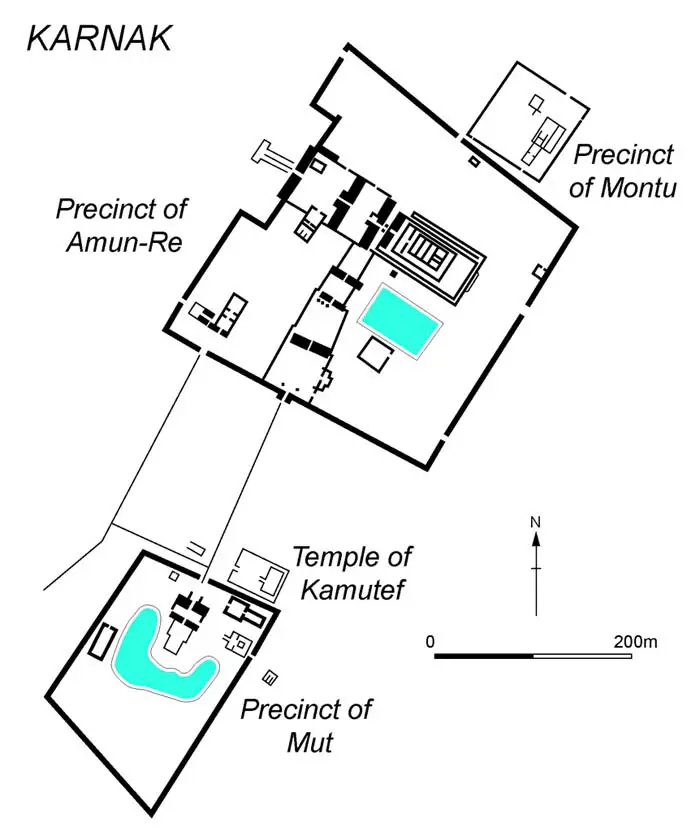
© Thomas Small - Layout of the Karnak Complex
Precinct of Amun
This complex contains the Great Temple of Amun and a variety of smaller temples. It is a massive precinct with a variety of buildings. It is difficult to see the true size of Amun’s temple in pictures.
The Amun Temple at Karnak
This temple has two axes; East-West toward the Nile and North-South toward Mut’s temple. The first pylon is at the Western entrance. Evidence shows that it was not completed. Criosphinxes line the processional way leading to the Nile. These statues had ram’s heads and were one of Amun’s emblems.
Several buildings are in the first courtyard. One of these is a triple barque station where the barques of Amun, Mut and Khonsu stopped during festivals. The remains of a giant kiosk also stands in this area but scholars are unsure of its use.
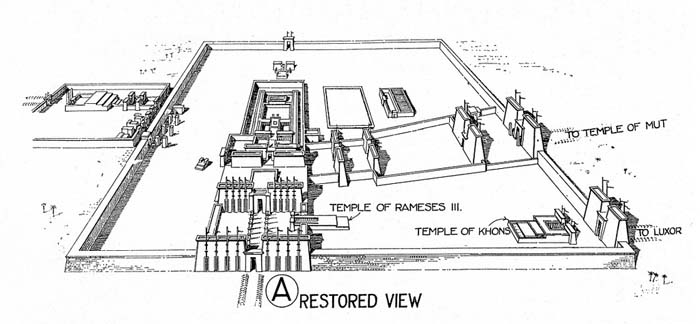
© psulibscollections - Reconstructed view of the Temple of Amun
A temple built by Ramesses III is on one side of the courtyard. This temple is a smaller version of the pharaoh’s mortuary temple. Statues of Ramesses III as Osiris line its small courtyard. This building was an elaborate barque shrine used when the Theban Triad traveled outside the temple.
The second pylon opens into the Great Hypostyle Hall. This large area has 134 columns topped by papyrus capitols. The twelve center columns are the largest. The area had a roof with small windows letting in some light. Each column is massive and several dozen people could stand on top of the largest ones.
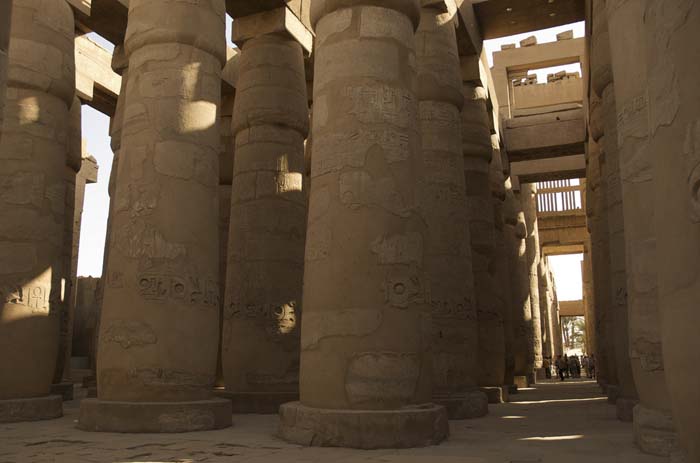
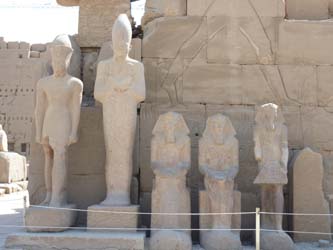
© Rick Manwaring - The Great Hypostyle Hall, Temple of Amun, Karnak
The third pylon leads to the court where the Southern axis begins. Four obelisks stood in this courtyard but only one remains.
The fourth and fifth pylons border the oldest remaining area of the temple. It is a court containing Egypt's largest obelisk, commissioned by Hatshepsut, and statues of Amun and Amunet, dedicated by Tutankhamun. Little remains of the inner sanctuary where the god’s statue resided.
The Southern axis begins with the seventh pylon. Scholars found a cache of 20,000 statues, statuettes and stelai in the courtyard beyond this pylon. Egyptologists are rebuilding pylons VIII to X, initially built by Hatshepsut (VIII) and Horemheb (IX and X).
Rebuilt Buildings
Pharaohs deconstructed older structures and used them as wall fillers. Scholars have rebuilt several chapels in the courtyard between pylons one and two that they found inside walls. One is the white limestone chapel of Senwosret I. Another is a red quartzite chapel built by Hatshepsut.
Festival Temple of Thutmose III
Thutmose III built a festival temple behind the inner core of Amun’s temple. It has some unique features. Some of its columns look like tent poles. The poles likely represented the poles of a military tent. Thutmose III conducted several military campaigns.
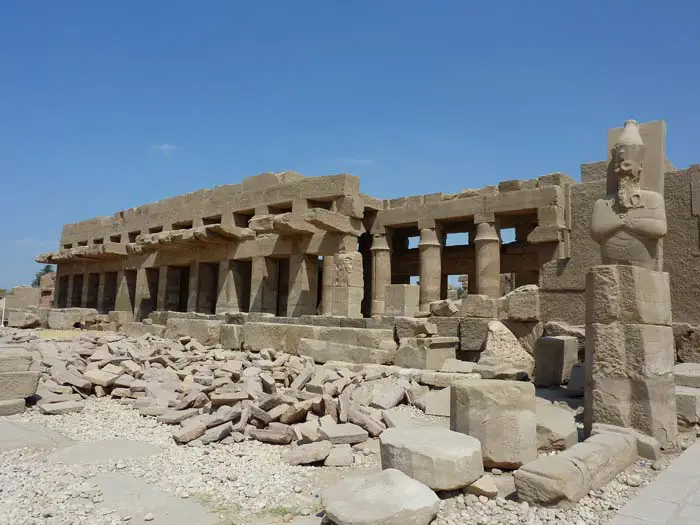
© Scott Sherrill-Mix - Festival Temple of Thutmose III
Khonsu Temple
A temple dedicated to Amun and Mut’s son, Khonsu is in the South-West corner of Amun’s precinct. It is a small temple that is relatively intact. A gate leads through the enclosure wall and links with Mut’s temple. There is a good view of Karnak from this building’s roof.
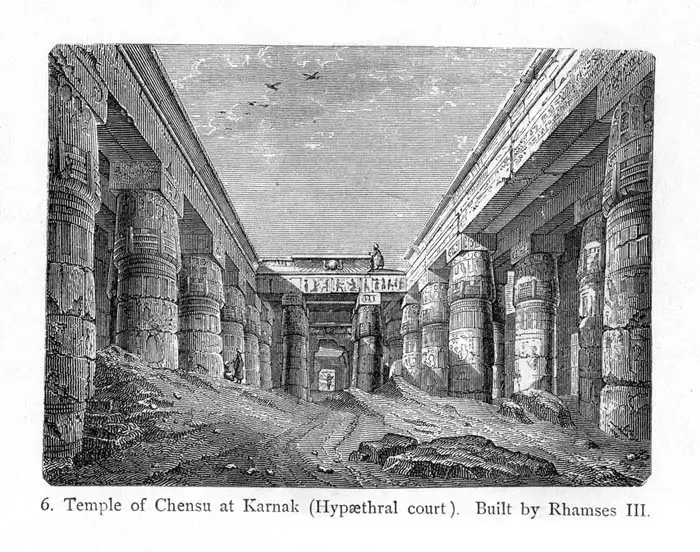
© psulibscollections - Khonsu Temple at Karnak
Opet Temple
Beside Khonsu’s temple is a small temple dedicated to the goddess Opet. This building served Amun in his form of Amun-Osiris. It has several crypts which the Egyptians used as tombs for the god. They also stored items used in a festival of resurrection in the crypts.
Sacred Lake
East of the Southern axis of Amun’s temple is the precinct’s sacred lake. It covers 100,000 square feet and scholars have filled it with water. The Egyptians used the lake for purification rituals and the priests’ daily ritual baths. Scholars found the remains of the priests’ houses near the sacred lake.
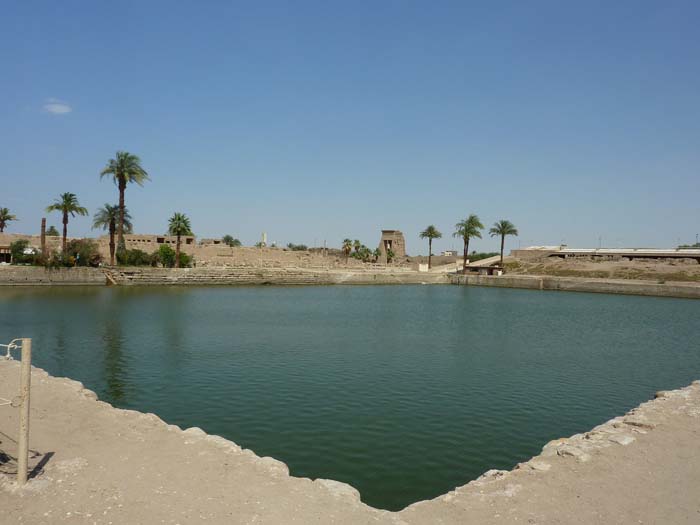
© Hannah Pethen - The Sacred Lake at Karnak
Ptah Temple
A temple dedicated to Ptah is near the Northern gate leading to Montu’s precinct. Ptah was a creator-god in Memphis. Three chapels were inside the temples core. Two were dedicated to Ptah and the third to the goddess Hathor. Today, a black granite statue of Sekhmet is in Hathor’s chapel.
Precinct of Mut
Temple of Mut
Mut’s temple is the largest in this complex. An entrance pylon leads to a narrow court. Another pylon opens into the inner core. This temple is famous for the black granite statues of Sekhmet that Amenhotep III placed there. Scholars believe he may have dedicated 700 of these statues. The precinct’s sacred lake encloses the temple on three sides.
Other Temples in Precinct
Several other buildings are in this precinct and two temples are well preserved. Ramesses III built one of them and decorated it with military scenes detailing his campaigns. Another temple was dedicated to the god Khonsupakherod (Khonsu the Child). This structure reused blocks from other buildings.
Structures between the Precincts of Amun and Mut
Two structures, that are now only foundations, lie between the Mut and Amun precincts. East of the connecting causeway is a temple dedicated to Amun Kamutef (Amun Bull of his Mother). West of the causeway is a barque shrine. Criosphinxes line the path between the precincts.
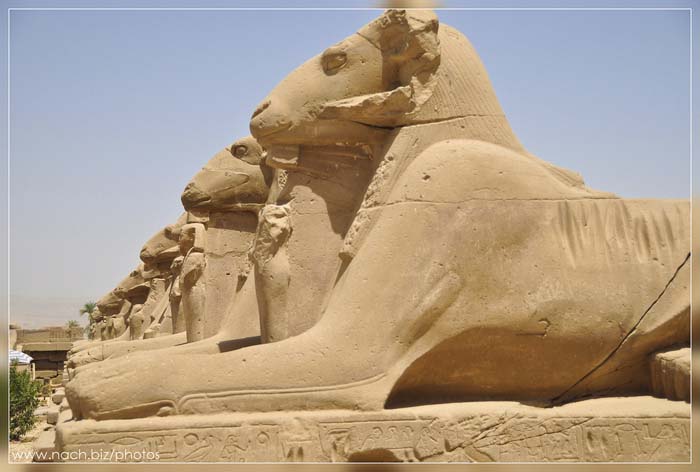
© -NACH- - Criosphinxes at Karnak
Precinct of Montu
Montu was the original falcon god of Themes. His temple is not well-preserved and has a North-South orientation. Parallel to Montu’s temple is one dedicated to the god Harpare, Montu’s son. A temple dedicated to Ma’at is at the Southern end of Montu’s temple.
Two buildings are outside the precinct. A temple built by Thutmose I is on the East. To the West, is a chapel dedicated to Osiris.
Temple of Akhenaten at Karnak
Akhenaten built a temple named Gem-pa-aten near Amun’s precinct during the first five years of his reign. After Akhenaten built Amarna, most of his building projects in Thebes stopped. Horemheb dismantled Gem-pa-aten and used it as filler to rebuild or expand Amun’s temple. Today, only Gem-pa-aten’s foundations remain in places.
Scholars are studying the temple’s remains to learn about its shape. This has been hard because modern homes cover most of the temple. Egyptologists think there was a large courtyard lined with a colonnade (a covered area held up by columns). They found statues of Akhenaten and Nefertiti in the court along with offering tables.
Part of the study of Gem-pa-aten includes the 36,000 blocks from the temple found inside the walls of Amun’s temple. Scholars have photographed them and tried to recreate the scenes on the walls. Images of rituals and the royal family have been pieced together. To date, more images of Nefertiti making offerings have been found than those of Akhenaten.
Karnak Facts
- Karnak is Egypt’s largest religious complex.
- Its Egyptian name was Ipetisut, “Most Select of Places.”
- Karnak consists of three precincts for Amun, Mut and Montu.
- Each precinct contains a main temple and smaller temples and chapels.
- Amun/Amun-Ra was the most important deity worshiped there.
- Pharaohs added to, restored or rebuilt Karnak.
- Karnak was one of Egypt’s religious centers.
- Scholars have found the foundations of and blocks from Akhenaten’s temple at Karnak and are studying the structure.
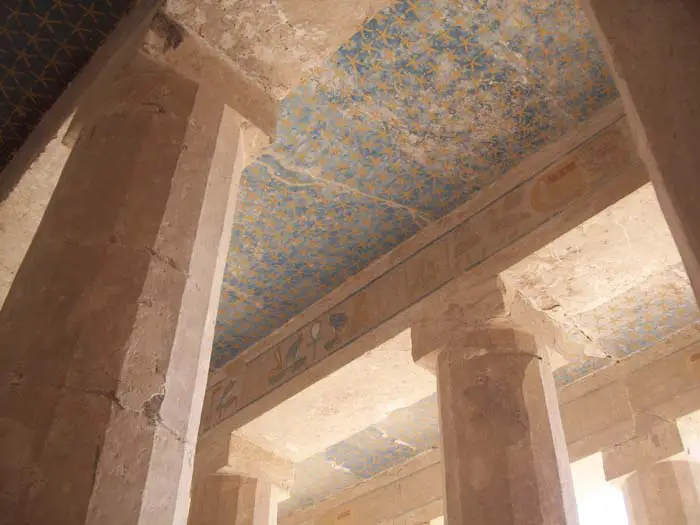
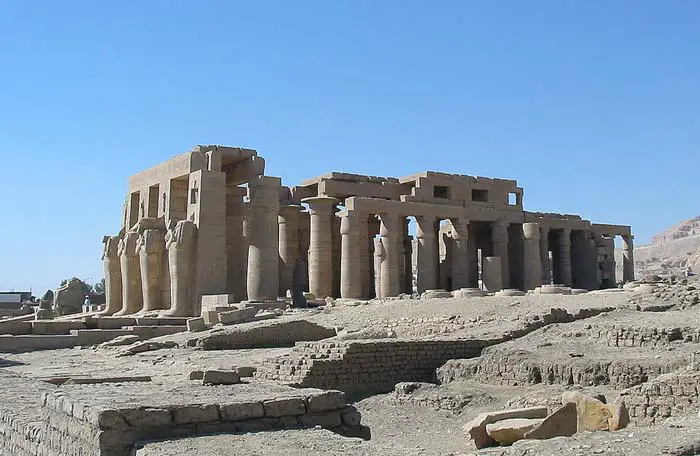
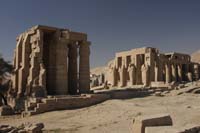
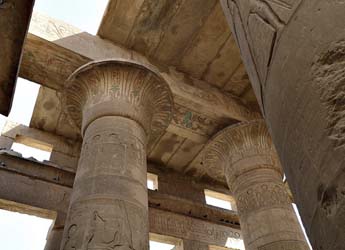
No comments:
Post a Comment